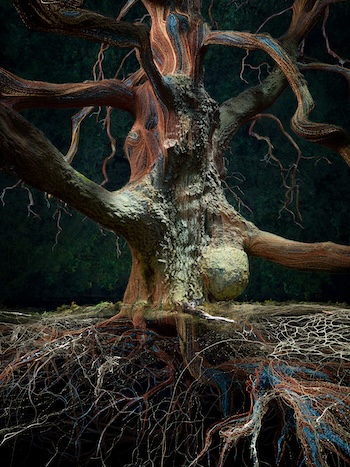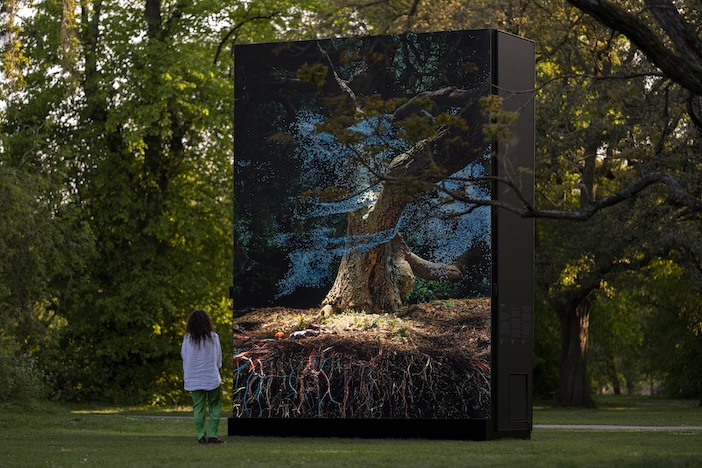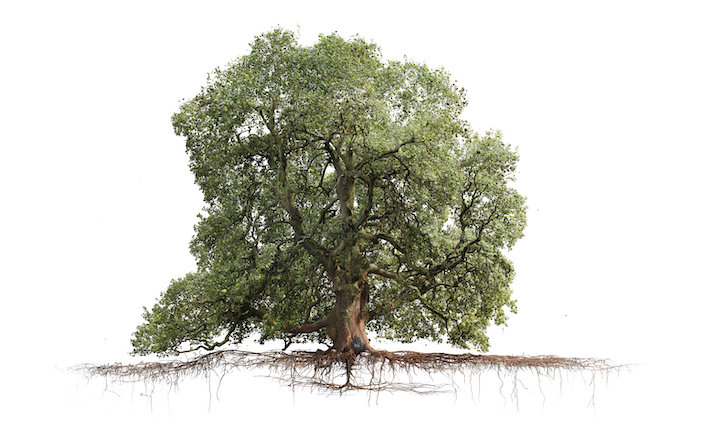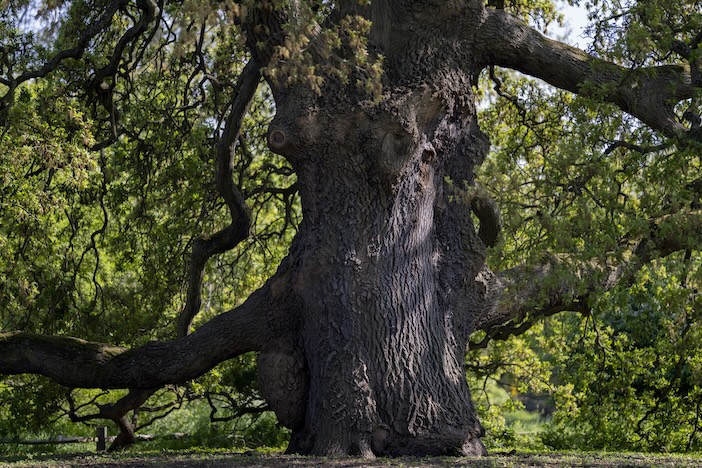“We aim to plant acorns in the human imagination…”
 That is the simple message to explain an extraordinary visual experience, fusing scientific research with visual and auditory creativity, to bring a centuries-old oak tree to life. Led by director Ersin Han Ersin, of digital film company Marshmallow Laser Feast, the interactive film shows the hitherto unseen flow of oxygen, water, and the sequestration of carbon dioxide, conducted through a tree’s roots, branches, leaves and bark, as it lives and, quite literally, breathes.
That is the simple message to explain an extraordinary visual experience, fusing scientific research with visual and auditory creativity, to bring a centuries-old oak tree to life. Led by director Ersin Han Ersin, of digital film company Marshmallow Laser Feast, the interactive film shows the hitherto unseen flow of oxygen, water, and the sequestration of carbon dioxide, conducted through a tree’s roots, branches, leaves and bark, as it lives and, quite literally, breathes.
Created for visitors to Kew Gardens this summer, ‘Of the Oak’, is a world-premiere digital art commission from an internationally renowned company, and the subject of this 12-minute interactive video installation is one of Kew’s oldest trees, the 253-year-old Lucombe oak.
Grown from a cutting of an original hybrid Turkey oak and Cork oak that naturally crossed in 1765, to put it in context it began life when George III was on the throne. It predates the French Revolution, the Battle of Waterloo and the invention of the hot air balloon. An icon of Kew, it is perfect casting for the film.
To chronicle the complete life form of this monolithic oak, the team used ground-penetrating radar to reveal its root and irrigation systems and to get a complete image of what lies underneath. What is so special is that this is the first time that MLF – an experiential artist collective – has been able to site their work right next to the object and subject of their film.
When it was about 75-years-old this Lucombe oak was uprooted in 1845, using horses, carts and many spades, to be moved from the ‘Syon Vista’ – the broad walk from Kew’s Palm House – directly toward Syon house. Kew’s landscape designer, William Nesfield, found that the growing tree was blocking the view, so it was moved a mere 60ft to the left of its original position.

Fittingly, its original position is the now the site of the ‘Of the Oak’ installation, a colossal 6-metre-high LED portal, so, while watching the outdoor film, the living oak stands before you with its branches spreading out, like welcoming arms. It being interactive, you can wave your arms to move the blue bubbles of oxygen around the ‘tree’, and if you want to get even closer, visitors can experience a guided meditation on the Of the Oak portal to synchronise your breath with the rhythm of the trees.
The ‘Of the Oak’ experience explores the oak tree’s physical reality with a certain hyperreality. It has to be seen. The oak is a special tree. For the first three hundred years of its life, it is a continuously growing entity to reach maturity. After that period for the next 300 years the tree lives its best life, full of health and vitality. The final 300-years finds it slowing down to reach a natural decline and dormancy.

To put that into perspective, that means that this 253-year-old tree is still growing, still expanding, still photosynthesising, releasing oxygen, drinking water. And not just existing itself, it is a hub of biodiversity with some 2,300 species are sustained within its ecosystem. The oak was even a source of food to our ancestors, who would eat the acorns. Today, acorns are not eaten raw – except by wildlife – but are used to make acorn flour, for breads and cakes, and acorn noodles and other variations of edible acorn foods.
Watching the film and looking at the Lucombe itself, the star of the show, one reflects on the senseless destruction in September 2023 of the 150-year-old Sycamore Gap tree in Northumberland, with no one around to save it from felling; and the barbaric recent destruction of a 450-year old oak in Enfield, north London – living its best life – destroyed by a restaurant food chain, to protect its car park. Knowing that these trees are living entities, and supporting life, makes it harder to understand such actions. MLFs film may go some way to ensuring a wider understanding of their significance and why these magnificent monoliths need protecting.

As well as the Lucombe Oak, there are plenty of other reasons to visit Kew this summer; there is a ‘Remarkable Trees’ trail through the gardens, and in the Shirley Sherwood gallery, an exhibition ‘The Power of Trees’, complements the ‘Of the Oak’ installation and invites visitors to explore the enduring beauty of trees across art and culture, and how trees have shaped human creativity.
Visitors may want to visit The Garden Museum in Lambeth, too, for a tree-related exhibition, The Lost Trees, created by artist Nancy Cadogan. Her creation of twenty works on display was instigated by trees forcibly felled in Cadogan’s neighbourhood to make way for the HS2 Rail project. She states that the loss of the trees was deeply felt with a sense of grief amongst residents. This exhibition explores the emotional, social and environmental impact of trees and their importance as a physical lifeblood in city communities, spreading out to the country landscape beyond.
‘Of the Oak’ is on at Kew Gardens until 28 September. Kew Gardens, Kew, Richmond, London, TW9 3AE. ‘Of the Oak’ ticket price is included in the entry fee to Kew Gardens. For more information, please visit Of the Oak | Kew.
The Lost Trees runs at The Garden Museum from 10th June to 20th July before going on a UK tour. The Garden Museum, Lambeth Palace Road, London, SE1 7LB. For more information, please visit www.gardenmuseum.org.uk.




